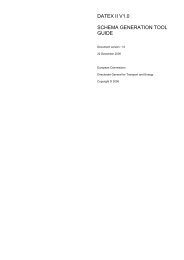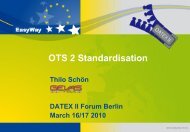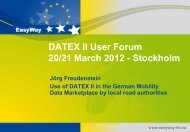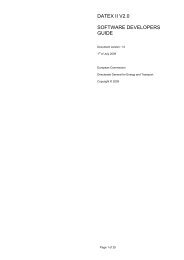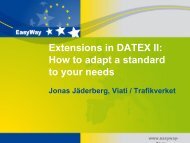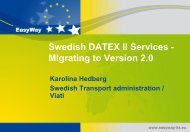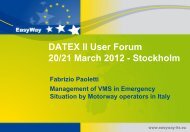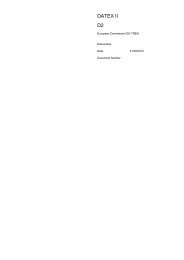Jörg Freudenstein, AlbrechtConsult GmbH - datex2
Jörg Freudenstein, AlbrechtConsult GmbH - datex2
Jörg Freudenstein, AlbrechtConsult GmbH - datex2
- No tags were found...
You also want an ePaper? Increase the reach of your titles
YUMPU automatically turns print PDFs into web optimized ePapers that Google loves.
DATEX II User Forum20/21 March 2012 - StockholmJörg <strong>Freudenstein</strong>Hands-on session:How to create a DATEX II profile?www.easyway-its.eu
Please note …..• These slides do not represent the complete hands-onworkshop• The step-by-step procedure is not exactly shown here• In fact, some interesting aspects are shown in a loose order• Without background knowledge, it might be difficult to understand• We consider to publish the hands on workshop in adifferent manner• maybe some kind of Webinar• Please be patient• Please also note the link list on slide 21DATEX II User Forum - Stockholm - 20/21 March 20122
Requirements for following the lecture1 Laptop with Windows 7 Windows XP should work as well(other platforms are currently not supported by the DATEX Tool).2 Enterprise Architect This tool is used for modelling the UML.Current version available for buying is 9.3. For modelling the DATEXstructures, the smallest edition, “Desktop”, is sufficient.Older versions of EA: I can confirm proper modelling with version 7.5, butmost likely even older versions should work, too.To get a copy free of charge, you can use the 30 day evaluation version,which is fully operational (proposed to select “Professional” version).(There is also an “EALite” version, which is a read only freeware. Note thatyou can use it to have a look at the UML model, but it cannot be used toparticipate the step-by-step course).Please be ready to use this tool (installation via typical installation routine).3 DATEX model It’s an .eap file to be used with Enterprise Architect (see above).Please download the latest copy (see on the right).4 DATEX Tool Please download the latest copy (see on the right).The Tool is used to create a DATEX II profile out of the DATEX data model.The files inside the ZIP have to be extracted and can be used withoutfurther installation (“D2conversion.exe”).5 XML-Viewer It is useful to have some XML Viewer/Editor available (e.g. XML Notepad)DATEX II User Forum - Stockholm - 20/21 March 20124
Handling Enterprise ArchitectDATEX II User Forum - Stockholm - 20/21 March 20125
Handling Enterprise ArchitectCheck your version!XDATEX II User Forum - Stockholm - 20/21 March 20126
DATEX II• Intelligent transport systems - DATEX II data exchangespecifications for traffic management and informationCEN/TS 16157 (Part 1 – 3)• Wide range of traffic data in standard modelToday• Selection of those elements, which are really used by theinterface• Creation of XML-schema exactly to the interface’s needs(tool based)• Adding missing content by extension – fully backward compatible77
DATEX II Methodology Document• Top level entry document into the DATEX IIspecification set• Describes the way that modeling is handled in DATEX II• Focusing on data model aspects• Data modeling in DATEX II takes a formal, metamodelbasedapproach that allows the process of generatingthe transfer syntax to be implemented in software• A tool that creates an XML schema from the DATEX IIdata model based on this methodology is available fromthis website88
DATEX Level A, B, C• Level A• Existing DATEX data model without any extensions• Level B-Extension• Extension of existing messages, fully compatible with existingsoftware• Level C-Extension• New message content, based on DATEX II mechanisms(new namespace)DATEX II User Forum - Stockholm - 20/21 March 20129
DATEX v2.0 PIM• Top level entry point: "Logical:D2LogicalModel“• publications• management information• exchange protocol meta-data• Supporting Information(see the specific specification on the Exchange Platform Specific Model)• Analysis• Dynamic• FunctionalDATEX II User Forum - Stockholm - 20/21 March 201210
Rules for Extensionsa) A model that is conforming to this Technical Specification may be extended. Extensions may either seekbackwards compatibility to an existing model (denoted 'core model' in this clause), or they may create a newmodel not compatible to any previous model, but nevertheless using the methodology provided within thisTechnical Specification and – potentially – reusing classes taken from other, existing models. A compatibleextension is denoted within this Technical Specification as a level B extension. Non-compatible extensions aredenoted as level C extensions.b) All extensions shall fully comply with all other rules presented so far in this document.c) An extended model shall provide extension name and version number in two tagged values called"extensionName" and "extensionVersion" on the “d2LogicalModel” element and on any other root level elements(defined using a “rootElement” tagged value), that shall be usable in conjunction with extended elements.d) Classes belonging to an extension and having a superclass not belonging to the extension (i.e. extension classesthat inherit from the core model) shall have an "extension" tagged value with values either "levelb" or "levelc".Extensions that do not add new root classes (i.e. classes that have a “rootElement” tagged value) are called“level B extensions”. These extensions shall set the “extension” tagged values to “levelb”. They are backwardscompatible with the standard model on message level. Extensions that introduce new root classes are called“level C extensions” and shall set the “extensions” tagged value to “levelc”.e) Classes belonging to an extension may not become superclasses of classes in the core model, i.e.specializations from a class from the extension to a class in the core model may not be added to the model.f) UML Associations may be added to the extended model that have a core model class on their source end and anextension class on their target end. Thus, existing classes from the core model may become components fromcontainers in the extensions model (class reuse), but classes from the extensions shall not become componentsof existing containers in the core model.g) Data types and enumerations of the core model may be reused in extensions.DATEX II User Forum - Stockholm - 20/21 March 201211
Using the DATEX II profile for generating new componentsDATEX II User Forum - Stockholm - 20/21 March 201212
Extensionclass TrafficSpeedExtended1TrafficSpeedTrafficSpeedExtendedTrafficDataThis is nogeneralisation.although thesame sort ofarrow is used+averageVehicleSpeed 0..1+minVehicleSpeed 0..1SpeedValue+maxVehicleSpeed 1DataValue+ speed :KilometresPerHourDATEX II User Forum - Stockholm - 20/21 March 201213
Tagged Values – The following Tagged Values are obligatory:• “definition” - text• for every package• for every component• for every attribute• for aggregations, in case twoor more aggregations areconnecting the same twocomponents• “order” - unique numberwithin object• for every attribute• for every literal• for every aggregation(on target)• “extension” – “levelb”• for a Level B component• “extensionName” and “extensionVersion”• in class D2LogicalModel, when using an extensionDATEX II User Forum - Stockholm - 20/21 March 201214
Export to XMI• Exchange format between UML and DATEX Tool isstandardized XMI• Whole package “D2LogicalModel” has to be exportedDATEX II User Forum - Stockholm - 20/21 March 201215
ExtensionInformation enteredvia tagged valuesDATEX II User Forum - Stockholm - 20/21 March 201216
Selection of Extension in the official DATEX Tool:DATEX II User Forum - Stockholm - 20/21 March 201217
Comparison not extended (left) and extended schema (right)Default Extensiontype for every(!)componentExplicit Extensiontype for the Level BextensionDATEX II User Forum - Stockholm - 20/21 March 201218
XML with additional values from extensionDATEX II User Forum - Stockholm - 20/21 March 201219
Validation of XML against schemaXML instance XSD (schema) validates?Without ErrorTrafficSpeedExtendedD2YESYESWith Error in Level AWith Error in Level BTrafficSpeedExtendedD2TrafficSpeedExtendedD2NONONOYESDATEX II User Forum - Stockholm - 20/21 March 201220
Links• DATEX II• http://www.<strong>datex2</strong>.eu• DATEX II Modelling Methodology• http://www.<strong>datex2</strong>.eu/sites/www.<strong>datex2</strong>.eu/files/DATEX_II_Methodology_2.pdf• Enterprise Architect• http://sparxsystems.eu/• http://www.sparxsystems.eu/enterprisearchitect/download-trial/• http://www.sparxsystems.com.au/bin/EALite.exe• DATEX platform independent model• http://www.<strong>datex2</strong>.eu/sites/www.<strong>datex2</strong>.eu/files/DATEX_II_PIM.EAP• DATEX schema generation tool• http://www.<strong>datex2</strong>.eu/sites/www.<strong>datex2</strong>.eu/files/DATEX_II_Schema_generation_tool.zip• DATEX schema• http://www.<strong>datex2</strong>.eu/sites/www.<strong>datex2</strong>.eu/files/Schema-2.0.zip• XML Viewer• http://www.microsoft.com/download/en/details.aspx?id=7973• Comparing files• http://winmerge.org/DATEX II User Forum - Stockholm - 20/21 March 201221
Thank you for your attention !Jörg <strong>Freudenstein</strong><strong>AlbrechtConsult</strong> <strong>GmbH</strong>Aachen, Germanyjoerg.freudenstein@albrechtConsult.comwww.easyway-its.eu



